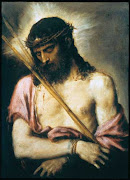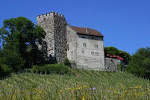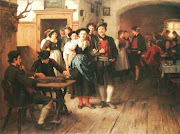"While I mostly agree with the attempted focus on the Good News as the common denominator of all Christian denominations, I find it rather difficult to reconcile the original teachings of the Scriptures with the traditions of the Roman Catholic church. Foremost in my disagreement is their way of exalting humans for whatever reason. I don't see why Mary should be able to hear anyone's prayers, given that she's dead and not a god. Neither do I quite get why every other person who did something is a saint- and in so doing greater than any other Spirit-Inspired human. While I don't doubt that the earliest beginnings of this Catholic church was let by Inspired men, I find it hard to believe that the Holy Spirit can work in this church today given their idolatry (see the above exultation of humans/objects) and the existence of copious amounts of pride in their ranks. Neither do I doubt that, as the above post illustrates, do they really live out a New Life in Christ."
For sheer pomposity and self-righteous arrogance, this one is a real peach, eh?
What makes this chap think that Protestant churches don't have "copious amounts of pride in their ranks".
As a matter of fact, they have Pride to over-flowing!
Idolatry means worshipping the created as if it were equal to the Creator. Giving honour to another human being is not idolatry. It is love, respect and affirmation.
Not everyone is of equal virtue - that is obvious. Some people are better than others. That's a fact. And the saints are the best of all.
This guy doesn't like the idea that there might be someone better than him. There's a word for that: it's called "Pride".
Why shouldn't Mary - or anyone in heaven - be able to hear our prayers?
And the simple reality is that the Bible is a Catholic book and the Catholic religion is the only truly Biblical religion.
The writer of the above is a Protestant who thinks he is better than Mother Teresa, St Francis of Assisi, St Damien of Molokai, St Bernadette, St Therese of Lisieux, St Thomas More, St Edmund Campion and all the saints whom he thinks do not "really live out a New Life in Christ".
Who, then, has the problem with Pride?
Here's another:
"WE ARE NOT SAVED BY GOOD WORKS.However good works are necessary to prove our faith. If we do not do good works , we do not demonstrate our faith and do what Jesus told us to. It's like a boy who joins the scouts but then refuses to wear the uniform.Using good works as our ticket to paradise is extreme selfishness."
Says who?
Errrrrr.....uuummm... he doesn't say. Why? Because he doesn't know. And because he will nowhere find his version of Christianity in the Bible.
In fact, quite the opposite. He will find that the Bible says that faith without works is DEAD. Fact.
Here is what it says:
"Do you see that by works a man is justified; and not by faith alone? ...For even as the body without the spirit is dead; so also faith without works is dead."
James 2:24,26
See? The Bible says that faith without works is dead and man is NOT justified by faith alone.
This verse alone demolishes the whole of classic Protestantism. And yet it come straight from the Bible.
Martin Luther so hated this verse that he took the Epistle of St James out of the Bible altogether and called it "Epistola straminea" - "an epistle of straw"!!
The fact is that the Bible is a Catholic book, chosen by Catholics and it teaches the Catholic faith.
Here's more:
"Dear Sir, You seem to idolize the Catholic Church and Catholics too much. Perhaps the 'anti-Catholic' comment made by yeomanrycavalry was out of order; but there might be some truth to it. If you believe, or have even read, what the Bible says, then you will agree that the one who is to be worshipped is not the Church, popes, images on walls, or people. All of us people, including popes, are subject to a strong sense of pride, self-righteousness and even stubbornness. It is not surprising that in ancient times people took the 'spiritual warfare' quite literally and crafted it into deadly crusades. We cannot justify that, as it was obviously a mistake and not something mentioned as a task in the Holy Scripture. In addition, your judgment towards yeomanrycavalry stating 'the usual, 'sex, money or power' is misplaced and contradictory. As it suggests that you are all-righteous in your daily living, something the Bible says there is 'not one righteous man' as Romans 3:10 says."
This comment is particularly self-righteous, proud and stubborn. But, then, we have come to expect that from certain types of Protestants.
What about "if you believe, or have even read, what the Bible says"?
Who's he kidding?
I quote the verses. He quotes none. And yet he claims to know it all. But that is all too typical of some.
In fact, as we have seen, the Bible is a Catholic document, selected by Catholics, teaching Catholic doctrine.
He fails to understand the meaning of Romans 3:10. When it says that "there is not any man just" this means that there is no man just by virtue either of the law of nature, or of the law of Moses, but only by faith and grace coming from Christ. THAT is what it means - but our Protestant friend thinks he knows better.
And therein lies another Protestant error: private judgement of Scripture. From this there has resulted over 90,000 different Protestant sects all claiming to teach the truth.
Whereas there is only ONE Catholic Church and it really DOES teach the true meaning of Scripture since that same Catholic Church CHOSE THE VERY BOOKS OF SCRIPTURE!
As to the Crusades, there are a wide variety of examples in Scripture of the people of God fighting battles to defend their culture, religion and way of life. Moses sanctioned this frequently and the Israelites did not scruple from war to defend themselves and their religion.
The inescapable fact is that the Crusades were a response to the invasion of the Eastern Roman Empire and the sacking of sacred Christian sites in the Holy Land by Muslims.
Thereafter Islam set itself to invade and capture the whole of Europe.
Was it wrong, or any surprise, that Christendom decided to defend itself from these marauders?
When Islamic Barbary pirates raided the coasts of Europe to kill all the men, rape the women and enslave them and all the children, was it wrong to fight them and defend Europe from such brutal and savage raiders? And yet that is what a "Crusade" was.
But Protestants simply do not know their history. As Blessed John Henry Newman wrote: "to be deep in history is to cease to be a Protestant".
One might also say "to be deep in Scripture is to cease to be a Protestant".
...







.jpg)

















_-002.jpg/220px-Circle_of_Anton_Raphael_Mengs,_Henry_Benedict_Maria_Clement_Stuart,_Cardinal_York_(ca_1750)_-002.jpg)

